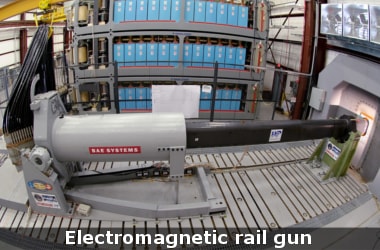
The US Navy has released a test video showcasing its experimental new weapon–the electromagnetic railgun.
With the capacity for firing projectiles at Mach 6, the railgun requires no explosives and can be fired using nothing but electricity making it a seriously cost-effective new choice for the Navy.
The railgun has long been portrayed by science fiction as a weapon of the future.
Using super-powerful electromagnets, it releases a solid projectile at almost impossible speeds over vast distances, all without using a single drop of gunpowder.
The railgun completely eliminates the need for an explosive shell. Due to the sheer speed the gun uses ‘slugs’ instead which cause damage through force.
The rail gun is already undergoing sea-trials and there have been rumours that the finished weapon will be installed on the US Navy’s state-of-the-art Zumwalt stealth ship.
Powered by a ‘pulse’ firing system that’s as small as a packet of cigarettes, the gun can send a slug through the air at speeds of up to Mach 6.
The weapon has a predicted range of 110-miles. It can achieve pinpoint accuracy even at that massive distance.
Mach Number: Know More- In fluid dynamics, the Mach number (M or Ma) (/m??x/; German: [ma?]) is a dimensionless quantity representing the ratio of flow velocity past a boundary to the local speed of sound.
- Mach 1 is equal to the speed of sound. Mach 0.65 is 65% of the speed of sound (subsonic), and Mach 1.35 is 35% faster than the speed of sound (supersonic).
- The Mach number is named after Austrian physicist and philosopher Ernst Mach, a designation proposed by aeronautical engineer Jakob Ackeret.